Q1. Define stele.
Solution
The stele is the group of all tissues which are present on the inner
side of the endodermis of a dicotyledonous root such as the pericycle,
vascular bundles and pith.
Q2. Describe the structural arrangement of collenchyma.
Solution
Collenchyma is a simple permanent tissue.
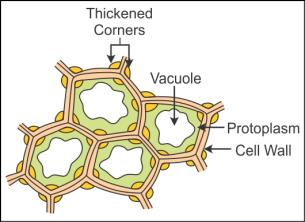 It is found either in the form of a homogeneous layer or in patches.
The cells are thickened at corners due to the deposition of cellulose, hemicelluloses and pectin.
Intercellular spaces are absent in collenchymas.
The cells are oval, spherical or polygonal.
They contain chloroplast and hence play role in assimilation of food.
It provides the mechanical support to the young growing parts of the plant.
It is found either in the form of a homogeneous layer or in patches.
The cells are thickened at corners due to the deposition of cellulose, hemicelluloses and pectin.
Intercellular spaces are absent in collenchymas.
The cells are oval, spherical or polygonal.
They contain chloroplast and hence play role in assimilation of food.
It provides the mechanical support to the young growing parts of the plant.
 It is found either in the form of a homogeneous layer or in patches.
The cells are thickened at corners due to the deposition of cellulose, hemicelluloses and pectin.
Intercellular spaces are absent in collenchymas.
The cells are oval, spherical or polygonal.
They contain chloroplast and hence play role in assimilation of food.
It provides the mechanical support to the young growing parts of the plant.
It is found either in the form of a homogeneous layer or in patches.
The cells are thickened at corners due to the deposition of cellulose, hemicelluloses and pectin.
Intercellular spaces are absent in collenchymas.
The cells are oval, spherical or polygonal.
They contain chloroplast and hence play role in assimilation of food.
It provides the mechanical support to the young growing parts of the plant.
Q3. What is the fate of the primary xylem in a dicot root showing extensive secondary growth?
Solution
The primary and secondary phloem get crushed due to the continuous formation and accumulation of the secondary xylem. However, the primary xylem remains intact in the centre of the stem.
Q4. State the functions of parenchyma.
Solution
Photosynthesis,
storage and secretion are the functions of parenchyma.
Q5. What is
secondary growth in plants?
Solution
The increase in girth of dicotyledonous plants is called secondary
growth.
Q6. Vessels and companion cells are found in
Solution
Vessels and companion cells are elements of vascular tissues found in higher plants such as angiosperms.
In Bryophytes and Thallophytes, vascular tissues are absent. Although vascular tissues are present in Pteridophytes (being the first vascular plants), the complexity in the structure of xylem and phloem is absent.
Q7. Cork tissue arises from
Solution
Cork tissue arises from the outer cells of phellogen.
Q8. Consider the following statements
1. In a dicot root, the vascular bundles are collateral and endarch.
2. The innermost layer of the cortex in a dicot root is the endodermis.
3. In a dicot root, the phloem masses separated from the xylem by parenchymatous cells are known as the conjunctive tissue.
Which of the statements given above are true?
Solution
1. In a dicot root, the vascular bundles are open and endarch.
2. The innermost layer of the cortex in a dicot root is the endodermis.
3. In a dicot root, the phloem masses separated from the xylem by parenchymatous cells are known as the conjunctive tissue.
Q9. Grafting is
successful in dicots but not in monocots because
the dicots have
Solution
The cambium possesses
the ability to form secondary xylem and phloem. It is present in dicots and absent in monocots. In case of grafting, it is
very important that the plant should form primary and secondary tissue for
its survival. Hence, grafting is successful in dicots.
Q10. In a dicot stem,
vascular bundles are
Solution
In a dicotyledonous
stem, the vascular bundles are arranged in a ring.
Q11. Differentiate
between heartwood and sapwood.
Solution
Heartwood
Sapwood
Present
in the central region of the secondary xylem.
Present
in the peripheral region of the secondary xylem.
It
provides mechanical strength to the stem.
Sapwood
conducts water and minerals from the roots to the leaves.
Q12. Radial conduction of water takes place by
Solution
Ray parenchyma cells are the cells of xylem parenchyma. They are present in wood rays and transport water laterally within the stem.
Q13. The waxy material
deposited in the casparian strip of the endosperm is
Solution
Suberin is a water-impermeable
waxy material which deposits in the cell walls of the endodermal cells.
Q14. Which one of the following statements pertaining to a plant structure is correct?
Solution
Sieve tube elements are the phloem elements. They are long tube-like structures arranged longitudinally. They are in association with the companion cells. The end walls are perforated in a sieve manner to from sieve plates.
Each cell lacks a nucleus, but it has a large vacuole and the peripheral cytoplasm.
Q15. What
are bulliform cells?
Solution
Adaxial epidermal cells in grasses which are present along the veins
modify themselves into large, empty, colourless cells called bulliform cells.
Q16. Some vascular bundles are described as open because these
Solution
In open vascular bundles, the cambium which is present between the xylem and phloem possesses the capacity to produce the secondary xylem and phloem.
Q17. In grasses, certain adaxial epidermal cells along the veins modify themselves into large empty, colourless cells called
Solution
In grasses, certain adaxial epidermal cells along the veins modify themselves into large empty, colourless cells called bulliform cells. These cells are responsible for the curling of leaf surfaces in grass.
Q18. Why do the open vascular bundles possess the ability to produce secondary vascular tissues?
Solution
Due to the presence of the cambium, the open vascular bundles possess the ability to produce secondary vascular tissues.
Q19. Closed vascular
bundles lack
Solution
In case of a closed
vascular system, the cambium is absent between the xylem and phloem.
Q20. The opening in the
core tissue which permits the exchange of gas between the atmosphere and the internal
tissue is called
Solution
The phellogen cuts
off closely arranged parenchymatous cells on the outer side of cork cells.
These parenchymatous cells rupture forming lenticels.
Lenticels permit
the exchange of gases between the outer atmosphere and the internal tissue of
the stem.
Q21. Name the plants whose phloem fibres are of
commercial importance.
Solution
The phloem fibres
of jute, flax and hemp are of commercial importance.
Q22. Define
lenticels.
Solution
The phellogen cuts off the closely arranged parenchymatous cells on
the outer side instead of cork cells. These cells soon rupture the epidermis
to form a lens-shaped structure called lenticels.
Q23. In land plants, the guard cells differ from other epidermal cells in having
Solution
In terrestrial plants, the epidermal cells are meant for protection. Guard cells contain chloroplasts. Hence, apart from the regulation of the opening and closing of stomata, they also carry out the process of photosynthesis.
Q24. Fascicular,
interfascicular and extrastellar cambium together constitute
Solution
Fascicular vascular
cambium, inter-fascicular cambium and extra-stellar (cork cambium) are
examples of the secondary meristem.
They occur in the
mature regions of roots and shoots. The secondary meristem is responsible for
producing secondary tissues.
Q25. The cork cambium,
cork and secondary cortex are collectively called
Solution
The cork cambium,
cork and secondary cortex are collectively called periderm.
Q26. Explain primary meristems and secondary meristems in
detail.
Solution
Primary
meristems:
There are two kinds
of primary meristems:
Apical meristems
Intercalary meristems
1. Apical meristems:
The meristems which occur at the tips of roots and shoots are called
apical meristems.
The root apical meristem is present at the tip of the root.
The shoot apical meristem is located at the distant most region of the
stem axis.
The apical meristem is responsible for the formation of young leaves
and elongation of stem and roots.
The shoot apical meristem gives rise to the axillary bud which may
form a new branch or a flower.
2. Intercalary meristems:
They occur between mature tissues.
They are found in grass. They help in the regeneration of parts
removed by the grazing animals.
Secondary Meristems:
They are also known as lateral meristems. They are cylindrical
meristems.
They occur in the mature regions of roots and shoots.
The secondary meristem is responsible for producing secondary tissues.
The fascicular vascular cambium, interfascicular cambium and cork cambium
are examples of the secondary meristem.
Q27. Cells of this
tissue are living and show angular wall thickening. They also provide
mechanical support. The tissue is
Solution
Collenchyma is a
simple permanent tissue.
The cells are
thickened at the corners due to the deposition of cellulose, hemicelluloses
and pectin.
It provides
mechanical support to the young growing parts of the plant.
Q28. Describe the sclerenchyma as a simple permanent
tissue.
Solution
Sclerenchyma is one
of the simple permanent tissues.
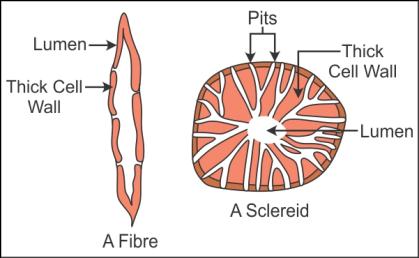 The cells are long,
narrow thick.
The cell walls are
lignified with numerous perforated pits.
The cells of sclerenchyma
are dead and without protoplast.
Sclerenchyma may be
in fibre form or in sclereid form.
The fibres are
thick walled, elongated and pointed cells occur in groups.
Sclereids are
spherical, oval or cylindrical.
Sclereids are
highly thickened dead cells with the narrow lumen,
Sclereids are found
in fruit walls of guava, nuts etc.
The sclerenchyma
provides the medical support to plants.
The cells are long,
narrow thick.
The cell walls are
lignified with numerous perforated pits.
The cells of sclerenchyma
are dead and without protoplast.
Sclerenchyma may be
in fibre form or in sclereid form.
The fibres are
thick walled, elongated and pointed cells occur in groups.
Sclereids are
spherical, oval or cylindrical.
Sclereids are
highly thickened dead cells with the narrow lumen,
Sclereids are found
in fruit walls of guava, nuts etc.
The sclerenchyma
provides the medical support to plants.
 The cells are long,
narrow thick.
The cell walls are
lignified with numerous perforated pits.
The cells of sclerenchyma
are dead and without protoplast.
Sclerenchyma may be
in fibre form or in sclereid form.
The fibres are
thick walled, elongated and pointed cells occur in groups.
Sclereids are
spherical, oval or cylindrical.
Sclereids are
highly thickened dead cells with the narrow lumen,
Sclereids are found
in fruit walls of guava, nuts etc.
The sclerenchyma
provides the medical support to plants.
The cells are long,
narrow thick.
The cell walls are
lignified with numerous perforated pits.
The cells of sclerenchyma
are dead and without protoplast.
Sclerenchyma may be
in fibre form or in sclereid form.
The fibres are
thick walled, elongated and pointed cells occur in groups.
Sclereids are
spherical, oval or cylindrical.
Sclereids are
highly thickened dead cells with the narrow lumen,
Sclereids are found
in fruit walls of guava, nuts etc.
The sclerenchyma
provides the medical support to plants.
Q29. Explain the structure of stomata with a labelled diagram.
Solution
Structure of stomata:
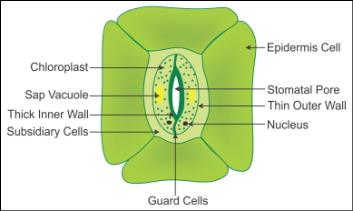 Stomata are present in leaf epidermis.
They regulate the process of transpiration and gaseous exchange.
They are enclosed by two bean-shaped guard cells.
The guard cells control the opening and closing of stomata.
Stomata are present in leaf epidermis.
They regulate the process of transpiration and gaseous exchange.
They are enclosed by two bean-shaped guard cells.
The guard cells control the opening and closing of stomata.
 Stomata are present in leaf epidermis.
They regulate the process of transpiration and gaseous exchange.
They are enclosed by two bean-shaped guard cells.
The guard cells control the opening and closing of stomata.
Stomata are present in leaf epidermis.
They regulate the process of transpiration and gaseous exchange.
They are enclosed by two bean-shaped guard cells.
The guard cells control the opening and closing of stomata.
Q30. Write the function of trichomes.
Solution
Trichomes prevent water loss which occurs during transpiration.
Q31. Describe the four elements of phloem.
Solution
The phloem is responsible for the transportation of food material from leaves to the other parts of the plant.
The four elements of the phloem are as follows:
1. Sieve tube elements:
They are long tube-like structures arranged longitudinally.
They are found in association with companion cells.
The end walls are perforated in a sieve manner to from sieve plates.
Each cell lacks a nucleus. It has a large vacuole and a peripheral cytoplasm.
2. Companion Cells:
Companion cells are specialised parenchymatous cells.
They help in maintaining the pressure gradient in the sieve tubes.
Nuclei of the companion cells control the function the sieve tubes.
3. Phloem Parenchyma:
The cells are cylindrical, elongated with tapering ends and dense cytoplasm and nucleus. The cells are connected to each other by plasmodesmatal connections.
The cell wall is composed of cellulose.
It also stores food and substances such as mucilage, latex and resin.
It is absent in monocotyledons.
4. Phloem Fibres:
They are also called bast fibres.
They are made of sclerenchymatous cells.
Phloem fibres are absent in the primary phloem but present in the secondary phloem.
Fibres are elongated, unbranded and bear pointed apices.
The cells walls are thick.
They lose their protoplasm at maturity and become dead.
The fibres of jute, hemp and flax are of commercial use.
Q32. Vascular cambium produces
Solution
Cells of vascular cambium produces secondary phloem on the outside and secondary xylem on the inner side. Youngest xylem layer occur inner to vascular cambium while oldest layer of secondary xylem is found outside the primary xylem or towards pith.
In phloem, youngest layer of secondary phloem lies outside the vascular cambium while oldest layer is towards outside, inner to primary phloem.
Q33. Which of the following is true?
Solution
Vessels are xylem elements. Each xylem vessel is made of many cells called vessel chambers. Because the vessels are devoid of protoplasm, they have a wide lumen.
Q34. The common bottle cork is a product of
Solution
Cells of phellogen consist of deposits of suberin. Suberin is a water impervious, buoyant and fire-resistant substance which makes the phellogen a perfect commercial substance for making the common bottle cork.
Q35. Draw well-labelled diagrams of
(a) Shoot Apical Meristem
(b) Root Apical Meristem
Solution
1. Root Apical Meristem:
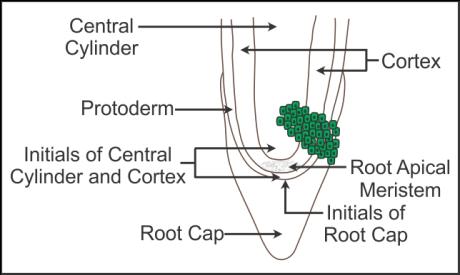 2. Shoot Apical Meristem:
2. Shoot Apical Meristem:
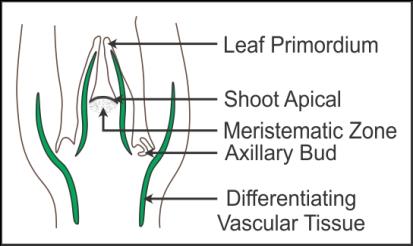
 2. Shoot Apical Meristem:
2. Shoot Apical Meristem:

Q36. Intercalary
meristem leads in
Solution
Intercalary
meristem is the primary meristem found between the regions of mature cells.
In plants such as grass, it regenerates the parts removed by grazing animals.
Q37. The monocot stem
lacks
Solution
In a monocot stem,
the cambium is absent; hence, the vascular bundles are known as closed type because
they do not show any secondary growth.
Q38. What are mesophyll cells?
Solution
Mesophyll cells are thin-walled chloroplast-containing
cells found in the ground tissue of leaves.
Q39. Distinguish between spring wood and autumn wood.
Solution
Spring Wood
Autumn Wood
Formed during spring.
Formed during autumn.
Number of xylary elements is more.
Number of xylary elements is less.
It is formed when the cambium is active.
It is formed when the cambium is less active.
The wood is lighter in colour with low density.
The wood is darker with higher density.
Q40. Distinguish between open vascular bundles and closed vascular bundles.
Solution
Open Vascular Bundles
Closed Vascular Bundles
1. Cambium is present between the xylem and phloem.
1. Cambium is absent.
2. It shows the ability of forming secondary xylem and phloem tissues.
2. It is not capable of forming the secondary xylem and phloem tissues.
3. It is found in dicotyledonous plants.
3. It is found in monocotyledonous plants.
Q41. Companion cells are
closely associated with
Solution
Companion cells and
sieve cells are derived from the same mother cell, and hence, they are in
close association with each other. Sieve elements and companion cells are
associated with each other through plasmodesmata.
Q42. As the secondary growth proceeds in a tree, thickness of
Solution
As a result of continuous secondary growth, the older part of secondary xylem becomes non-functional. The function of secondary xylem is continuous by sapwood or alburnum. With addition of new outer rings of secondary xylem, more rings of sapwood changes into heartwood. So, the heartwood increases in diameter year after year but the sapwood remains in same thickness
Q43. The long plants are capable of standing erect due to the presence of
Solution
Sclerenchyma is a simple permanent tissue. Its function is to provide mechanical support to plants.
Q44. Describe the four elements of xylem.
Solution
The xylem is a
complex permanent tissue which conducts water and minerals from the roots to
the different parts of the plant.
It is also responsible
for the mechanical strength of the plant.
It is composed of
four elements - tracheids, xylem vessels, xylem fibres and xylem parenchyma.
1. Tracheids:
Tracheids are elongated tube-like structures.
They have thick cells with tapering ends and lignified cell walls.
The cells are dead and without protoplasm.
2. Vessels:
Vessels are cylinder-like structures made of many cells called vessel
members.
Cells possess a large cell cavity, and the cell walls are lignified.
They are interconnected to each other through the perforations in
their common walls.
3. Xylem Fibres:
They are with highly thickened walls and obliterated lumen.
They are either septate or aseptate.
4. Xylem Parenchyma:
The cells are living and thin walled.
Their cell walls are made of cellulose.
Xylem parenchyma is responsible for the radial conduction of water in
plants.
It also stores food in the form of starch or fat and substances such
as tannin.
Q45. State the function of the cuticle.
Solution
The cuticle prevents the loss of water from the
surface of leaves.
Q46. What is
early bark and late bark?
Solution
The bark which forms in early season is called early bark, and the
bark which forms towards the end of the season is called late bark.
Q47. Define
heartwood.
Solution
The region of dead elements with highly lignified walls in old trees
is called heartwood.
Q48. The lateral roots
originate from
Solution
Lateral roots and
the vascular cambium originate from the pericycle.
Q49. Identify the missing parts in the diagram given
below. Draw the diagram again with all the labels.
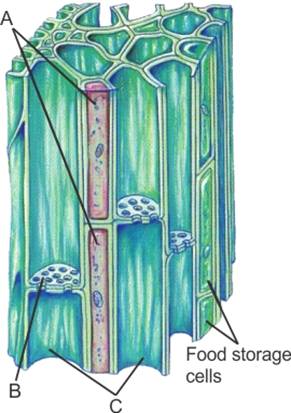

Solution
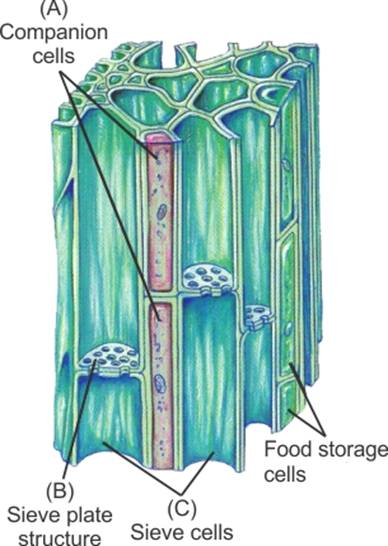
Q50. Identify and write the name of the tissue shown
below.


Solution
The given diagram
is of a sclerenchyma fibre.
Q51. Jute fibres are obtained from the
Solution
The phloem fibres of jute are of commercial importance. Phloem fibres, the phloem element, are generally absent in the primary phloem but present in the secondary phloem.
Q52. Name
the two tissues which are involved in secondary growth.
Solution
The two tissues involved in the secondary growth of plants are
vascular cambium and cork cambium.
Q53. Differentiate between apical meristem and lateral
meristem.
Solution
Apical Meristem
Lateral Meristem
It
occurs at the tips of roots and shoots.
It
occurs in the mature regions of the roots and shoots.
They
produce primary tissues.
They
produce secondary tissues.
It
is responsible for the formation of young leaves and elongation of
roots and stems.
It
is responsible for producing a woody axis and for the thickness of the
plant.
Q54. Draw a diagram of the conjoint closed vascular bundle.
Solution

Q55. Describe the vascular tissue system and its types.
Solution
The vascular tissue system consists of xylem and phloem.
Xylem and phloem are collectively called vascular bundles.
There are four types of vascular bundles:
Open vascular bundles: The cambium is present between the xylem and phloem. The cambium possesses the ability to form secondary xylem and phloem tissues. Such types of vascular bundles are found in the stems of dicotyledonous plants.
Closed vascular bundles: There is no cambium present between the xylem and phloem. Such types of vascular bundles are found in monocot stems.
Radial vascular bundle: The xylem and phloem are arranged in different radii within the bundle. Such arrangement is seen in roots.
Conjoint type of vascular bundle: The xylem and phloem are situated at the same radius in the bundle. The phloem is located on the outer side of the xylem. Such types of vascular bundles are commonly seen in stems and leaves.
Q56. Enlist the elements of xylem.
Solution
Elements of xylem
are tracheids, vessels, xylem fibres and xylem parenchyma.
Q57. Which meristem is the cylindrical meristem?
Solution
Secondary meristem
is the cylindrical meristem.
Q58. Distinguish between xylem and phloem.
Solution
Xylem
Phloem
It
conducts water and minerals from the roots to the stem and leaves.
It
transports food materials from the leaves to the other parts of the
plant.
It
is composed of tracheids, vessels, xylem fibres and xylem parenchyma.
It
is composed of sieve tube elements, companion cells, phloem parenchyma
and phloem fibres.
Q59. What is the stomatal apparatus?
Solution
The stomatal aperture, guard cells and subsidiary
cells surrounding the guard cells are collectively called the stomatal
apparatus.
Q60. State the function of companion cells.
Solution
The function of
companion cells is to maintain the pressure gradient in sieve tubes.
Q61. Distinguish between parenchyma and collenchyma.
Solution
Parenchyma
Collenchyma
Cells
are thin and contain cellulose.
Cells
are thickened at the corners and contain cellulose, hemicelluloses and
pectin.
Cells
are either closely packed or have small intercellular spaces.
Intercellular
spaces are absent.
It
performs functions such as photosynthesis, storage and secretion.
It
gives mechanical support to the growing parts of the plant.
Q62. Name
the substances which make the secondary xylem of old trees hard.
Solution
The substances which make the secondary xylem of the old trees hard
are resins, tannins, oils, gums, aromatic substances and certain essential
oils.
Q63. Enlist the elements of phloem.
Solution
The elements of
phloem are sieve tube elements, companion cells, phloem parenchyma and phloem
fibres.
Q64. Given below is the diagram of the radial vascular bundle. Write the
name of regions labelled as A and B in the diagram.


Solution
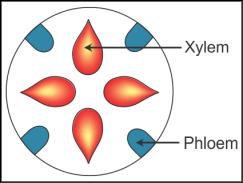
Q65. What is
a conjunctive tissue?
Solution
A conjunctive tissue is a group of parenchymatous cells which lie
between the xylem and the phloem in a dicotyledonous root.
Q66. Name the tissues which form the vascular tissue system.
Solution
The tissues xylem and phloem form the vascular
tissue system.
Q67. Name the two major groups of tissues.
Solution
The two major
groups of tissues are meristematic tissues and permanent tissues.
Q68. Why are the cells of collenchyma much thickened at the corners?
Solution
Due to the deposition of cellulose, hemicelluloses and pectin, the cells of the collenchyma are much thickened at the corners.
Q69. Differentiate between collenchyma and sclerenchyma.
Solution
Collenchyma
Sclerenchyma
Cells have
thin cells walls.
Cells
have thick lignified cell walls.
It is in the
form of oval, spherical or polygonal cells.
It
is in the form of sclereids and fibres.
The cells
are alive.
The
cells are dead.
It provides
mechanical support to the young growing parts of the plant.
It
gives mechanical support to the plant organs.
Q70. State
the type of vascular bundles seen in a monocotyledonous stem.
Solution
The type of vascular bundles seen in a monocotyledonous stem is of
conjoint and closed type.
Q71. When a vascular bundle is called a closed vascular bundle?
Solution
When cambium is absent between the xylem and phloem, the vascular bundle is called a closed vascular bundle.
Q72. Draw the diagram of collenchyma tissue.
Solution
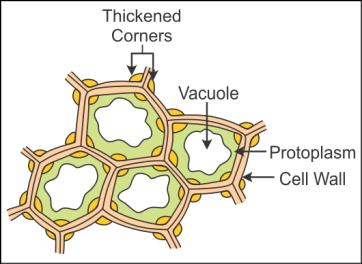
Q73. Give two examples of fruits which consist of
sclereids in their walls.
Solution
Pear and guava consist
of sclereids in their walls.
Q74. State
the function of lenticels.
Solution
Lenticels allow the exchange of gases between the outer atmosphere and
the internal tissue of the stem.
Q75. Explain the following terms:
Exarch
Endarch
Solution
Exarch: It is a type of primary xylem in which
the protoxylem lies towards the periphery while the metaxylem lies
towards the pith.
Endarch: It is a type of primary xylem in which
the protoxylem lies towards the pith (centre) and the metaxylem lies
towards the periphery of the organ.
Q76. Write the names of three simple tissues found in
plants.
Solution
Three simple
tissues found in plants are parenchyma, collenchyma and sclerenchyma.
Q77. Distinguish between meristematic tissue and
permanent tissue.
Solution
Meristematic Tissue
Permanent Tissue
Cells
show great potential of cell division.
1. Cells have lost the capacity to divide.
The
cells are located at specific regions such as root tips, shoot tips
etc.
2. This type of tissues is present in
the entire plant body.
This
tissue is responsible for plant growth.
3. This tissue is involved in functions
such as conduction of water, minerals, food materials etc.
Q78. Name the following:
Thin-walled cells containing chloroplasts,
present in the ground tissue of leaves.
The vascular bundle common in stems and leaves.
Solution
Thin-walled cells containing chloroplasts,
present in the ground tissue of leaves - Mesophyll cells
The vascular bundle common in stems and leaves
- Conjoint type of vascular bundle
Q79. Distinguish between the dorsiventral leaf and the isobilateral leaf.
Solution
Dorsiventral Leaf
Isobilateral Leaf
The number of stomata is more on the abaxial epidermis than the adaxial epidermis.
Almost equal number of stomata is present on the abaxial and adaxial surfaces.
Mesophyll is differentiated into spongy and palisade parenchyma.
Mesophyll layer is not differentiated into spongy and palisade parenchyma.
Vascular bundles are large and vary in size as per the size of veins.
Vascular bundles are similar in size, only the bundles near the mid vein are large.
Bulliform cells are absent.
Bulliform cells are present.
Q80. Understand the given description and name the cells
or tissues.
In dicotyledonous plants, it occurs in layers
below the epidermis.
Responsible for the radial conduction of water
in plants.
Central lumens are obliterated.
Solution
In dicotyledonous plants, it occurs in layers
below the epidermis: Collenchyma
Responsible for the radial conduction of water
in plants: Xylem parenchyma
Central lumens are obliterated: Xylem vessels
Q81. Write
the two kinds of tissues found in the mesophyll layer of a dorsiventral leaf.
Solution
The two kinds of tissues found in the mesophyll layer of a
dorsiventral leaf are palisade parenchyma and spongy parenchyma.
Q82. Define tissue.
Solution
A tissue is a group
of cells which have a common origin and they usually perform a common
function.
Q83. Answer the following with respect to the arrangement of cells in a dicot stem.
Where are the medullary rays located?
What is the function of the hypodermis?
State the location of the pericycle.
Solution
Medullary rays are located in between the vascular bundles.
Hypodermis provides mechanical strength to the young stem.
Pericycle is located on the inner side of the endodermis and above the phloem in the form of semi-lunar patches.
Q84. Draw the diagrams of tracheids and vessels. Explain
the form of cells found in them.
Solution
In tracheids, cells
are elongated, thick with lignified cell walls and tapering ends.
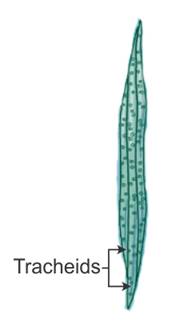 In vessels, the
cells are long, cylindrical with lignified walls and a central cavity.
In vessels, the
cells are long, cylindrical with lignified walls and a central cavity.
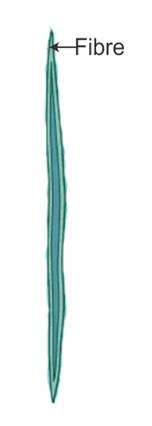
 In vessels, the
cells are long, cylindrical with lignified walls and a central cavity.
In vessels, the
cells are long, cylindrical with lignified walls and a central cavity.

Q85. Define subsidiary cells.
Solution
The epidermal cells which lie near the guard cells
and have become specialised in their shape and size are called subsidiary
cells.
Q86. State the names of the three tissue systems.
Solution
The three tissue systems are
Epidermal tissue system
Ground tissue system
Vascular tissue system
Q87. Draw the diagram of parenchyma and describe the tissue in brief.
Solution
Parenchyma is a simple permanent tissue.
 Its cells are isodiametric. They are oval, spherical or elongated in shape.
There may be intercellular spaces between the cells.
The cells walls are thin and made of cellulose.
Photosynthesis, storage and secretion are certain functions performed by the parenchyma.
Its cells are isodiametric. They are oval, spherical or elongated in shape.
There may be intercellular spaces between the cells.
The cells walls are thin and made of cellulose.
Photosynthesis, storage and secretion are certain functions performed by the parenchyma.
 Its cells are isodiametric. They are oval, spherical or elongated in shape.
There may be intercellular spaces between the cells.
The cells walls are thin and made of cellulose.
Photosynthesis, storage and secretion are certain functions performed by the parenchyma.
Its cells are isodiametric. They are oval, spherical or elongated in shape.
There may be intercellular spaces between the cells.
The cells walls are thin and made of cellulose.
Photosynthesis, storage and secretion are certain functions performed by the parenchyma.
Q88. Describe guard cells.
Solution
Guard cells are bean-shaped cells present on either
side of a stoma. The inner walls of the guard cells are thick, while the
outer walls are thin. Guard cells possess chloroplasts and regulate the
opening and closing of the stomata.
Q89. What is
periderm?
Solution
The cells of the phellogen, phellem and phelloderm are collectively
called the periderm.
Q90. The endodermis of a dicot stem is also called starch sheath. Justify.
Solution
The cells of the endodermis in a dicot stem are rich in starch grains, and hence, it is called a starch sheath.
Q91. What are mature cells?
Solution
In primary and
secondary meristems, following division, the newly formed cells become
structurally and functionally specialised and lose the ability to divide.
Such cells are called mature cells.
Q92. Give any one example in which the guard cells are dumb-bell shaped.
Solution
Grass
Comments
Post a Comment